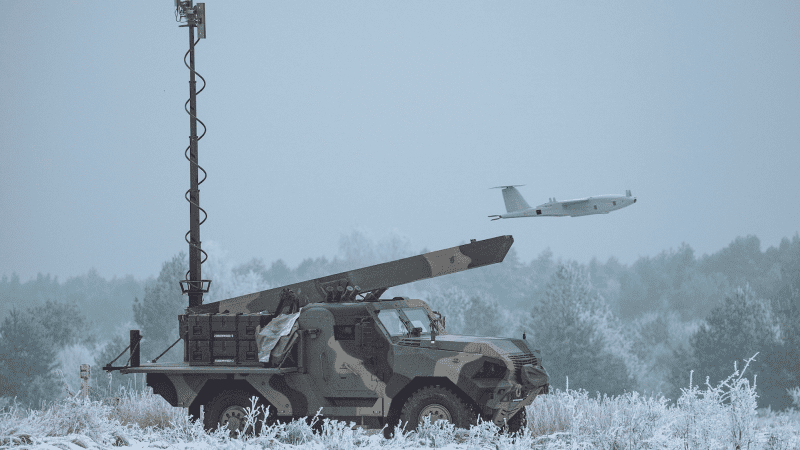Defence Policy
Transformation - More Than Just Modernization. Chief of the General Staff Outlines the Plan for Changes in the Polish Armed Forces

Photo. WB Group
A new approach to readiness, “dronization”, mass procurement of the individual kit elements, establishing a transformation command, and an entirely new approach towards reserves, and skills and talent management – these are just some of the elements of assumed changes in the development of the Armed Forces, outlined by the Chief of the General Staff, General Wiesław Kukuła.
During the “Deterrence and Strategic Communications” workshop at the general staff, assumptions were adopted for an entirely new approach to the development of the Polish Armed Forces. Chief of the General Staff of the Polish Armed Forces, General Wiesław Kukuła, and Deputy Chief of the General Staff General Piotr Błazeusz, Deputy Chief of the General Staff Div. General Karol Dymanowski, General Krzysztof Król, and Col. Bogdan Sowa and col. Janusz Misiak all made speeches during the conference. During the workshop, various aspects tied to the development of the Armed Forces and deterrence were presented, within the context of NATO cooperation, the evolution of threats, and the establishment of state resilience.

Photo. General Staff of the Polish Armed Forces/Twitter
When it comes to the newly adopted approach, concerning the development of the Polish Armed Forces, transformation is the key assumption - involving a complex establishment of capabilities in a sustainable manner, according to the DOTLMPFI principle (Doctrine, Organization, Training, Leadership, Materiel, Personnel, Facilities, Interoperability).
That translates into a departure from an approach focused on modernization alone, revolving solely around filling the gaps identified through procurement, but not always entailing a proper support framework. General Kukuła noted that the transformation necessity would mean that changes need to be comprehensive. This is one of the first conclusions drawn from the General’s visit to the US.
The Transformation of the Armed Forces remains one of four effort lines identified by the Chief of the General Staff. The remaining ones include deterrence and defence readiness, development of defence and state resilience awareness, and building good value of service, with support for families and veterans.
When it comes to deterrence and defence readiness, a new readiness approach is planned to be adopted, in line with the NATO New Force Model. In simple terms that means the forces would be divided into three readiness categories. Category I units are to maintain top-tier readiness and be able to respond to threats immediately - which would also entail numerous professional soldiers being assigned to those units. Category III elements are to be formed mainly by the active reserves, and they would attain operational readiness in 180 days from the date of activation. That should secure the Armed Forces in the event of a potential conflict and is aligned with the NATO data.
General Kukuła also referred to the definition of combat readiness, and the definition of transformation, as viewed by the Polish Armed Forces. The combat readiness needs to be worked on today. Transformation, meanwhile, is understood as maintaining continuous superiority over the adversary. The transformation process would need the mentality to be shifted, along with a proper institutional framework. The process is to be coordinated by the newly formed transformation command, modelled after the US TRADOC. Alongside the comprehensive adoption of new capabilities, the new structure is also to deal with individual training of recruits, and also manage their career and personal development paths. Thus, the Division commanders will be able to deal with training and readiness to a greater extent, instead of handling the basic training - as it is happening now.
The Chief of the General Staff emphasized the fact that people are the most important element of the Armed Forces, and the soldiers need to be constantly ready to manage change. A talent management system is to be established within the Polish Armed Forces so that the positions the soldiers take match their competencies and skills. US ASVAB test was mentioned as an example, involving all soldiers who are recruited. Thanks to that test, the soldiers may be assigned positions according to their predisposition. A similar solution, known as the Military Competency Test, is to be implemented in Poland. The newly created Transformation Command would be responsible for nurturing the talents of the individual troops.
It was announced during the conference that efforts would be undertaken towards implementing Total Force Concept solutions, including homogeneous standards for kits for all forms of military service. Especially in case of the simple specialities, homogenized standards as such are attainable. The Chief of the General Staff also stressed that the Polish Armed Forces are to be ultimately 450 thousand men strong, which, with the inclusion of active reserve, would translate into a serious increase of the quantitative potential. A new model for training and maintaining readiness in the reserves would also be created.
Solutions designed to increase retention (keeping soldiers in active service) would be implemented as well. The P1 Division of the General Staff for Organization and Recruitment is to establish a careers management system in the Polish Armed Forces, and also work on the implementation of a contracts-based system for selected specialties, like the aircrews. The bonus system and non-financial forms of motivation would also be reformed.
General Kukuła also mentioned the fact that deterrence will always be cheaper than actually defending the state, even with defence expenditure at the level of 6% of annual GDP. Thus, not only should the capabilities be developed, but communications regarding those capabilities shall also be cohesive. When it comes to areas of development of the operational capabilities of the Armed Forces between 2024 and 2039, air/missile defence is still a priority, along with balancing the Russian advantage in the strike system, including stand-off capabilities. Another relevant action would result in a structural change of battalion elements, by reducing the number of heavy platforms (main battle tanks, IFVs) to 44, with the simultaneous addition of reconnaissance and unmanned components.
Simulations conducted at the Center for Doctrines and Training of the Armed Forces have shown that a unit as such has a major advantage over a conventional, 58-vehicle strong battalion without support elements, and also has a smaller EM signature, or logistics requirements. “Dronization” of the Armed Forces is to be intensified, with the commissioning of unmanned systems and AI, and the establishment of cost-effective systems across the whole command-reconnaissance-strike chain. A Joint Unmanned Systems Component is also expected to be formed and developed.
General Kukuła outlined the development of capabilities to conduct cognitive/information warfare and the effort aimed at getting the Polish Armed Forces involved deeper in the space domain. Finally, “Operacja Szpej” (“Operation Kit”) is to be a relevant domain of activities, aimed at the rapid introduction of large quantities of modern individual equipment pieces. The current status, after several years of backlog in this area, hurts the morale, also among the reserves.
